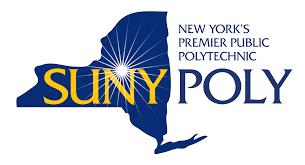GMSPD 25 Workshop
Geometric Mechanics, Structure Preserving Discretization, and Discrete Differential Geometry on General Fibered Manifolds
July 21st - 25th, 2025SUNY Polytechnic Institute, Utica, NY
Andrea Dziubek (SUNY Poly), Michael Neunteufel (PSU, OR), Michael Karow (TU Berlin, Germany)
In the last decades, different fields emerged to discretize and simulate physical problems in a structure-preserving, efficient and stable manner (DEC, FEEC, DDG). On the other hand, geometric mechanics (GM) became a powerful framework in continuum mechanics and generalized materials, such as plasticity and defect theory and, nowadays, also for (manufactured) metamaterials. The advances of both groups rely on the same techniques from modern differential geometry and algebraic topology, with numerical analysis bridging the gap.
Cartan's exterior calculus expresses the derivative operators (div, grad, curl) in terms of the more fundamental wedge product, exterior derivative, and Hodge star operators and separates metric information from topology. This unifies the classical integral theorems (Green's, Stokes', Gauss's), with de Rham cohomology being the link between differential forms and topology. The translation of the equations of elasticity to exterior calculus came somewhat later compared to electromagnetism, fluids, and general relativity; it first had to be worked out that the stress tensor is a vector-valued two form.
The discretization of scalar-valued differential forms on a manifold is now well-understood. However, the discretization of differential forms with values in a vector-bundle with a connection is notoriously difficult and requires advanced concepts from functional analysis, modern differential geometry, algebraic topology, and numerical mathematics.
GM for Cosserat materials and dislocations, where the manifold describing the location of the material is different from the manifold for the additional degrees of freedom, involves vector-bundle valued differential forms.
From DEC we know that pairing values on chains (cochains) with chains is the discrete analogue of integration of a continuous scalar-valued differential form over a domain. Taking the discrete exterior derivative as the adjoint of the boundary operator on chains then leads to a structure-preserving discretization of the Stokes' theorem or the de Rham cohomology. Other DEC operators are a robust discrete Hodge star and a discrete wedge product. DEC has been successfully applied to the Navier-Stokes equations.
FEEC used cohomology and Hodge theory to derive a unified framework to build a discrete de Rham complex that is isomorphic to its continuous version. Milestones were the derivation and analysis of stable mixed finite element discretizations of the Hodge-Laplacian eigenvalue problem and Maxwell's equations. The work of so-called twisted complexes enabled the description of more involved physical problems, such as Cosserat elasticity and linearized Riemann-Cartan geometry in this framework.
The field of DDG aims to develop a framework for the discrete counterpart of differential geometry on smooth manifolds and their convergence. Focus has been on the crucial case of polyhedral surfaces consisting of triangles and quadrilaterals approximating a smooth surface embedded in R3. Several discrete curvature operators and other differential geometry objects, such as connections, have been defined on the approximated manifolds, and convergence of these objects under mesh refinements has been investigated.
We aim to advance the understanding of the cross-section of Geometric Mechanics, Numerical Mathematics, and Discrete Differential Geometry. Knowledge is created, shared, applied, and evolves, "It needs to be nourished to flourish". By reaching a diverse audience, the workshop contributes to a broader infrastructure for knowledge creation and preservation in the fields of GM and SPDs and to strengthening the national scientific community.
Contact Information
-
Andrea Dziubek,
dziubea 'at' sunypoly 'dot' edu
-
Michael Neunteufel,
mneunteu 'at' pdx 'dot' edu


